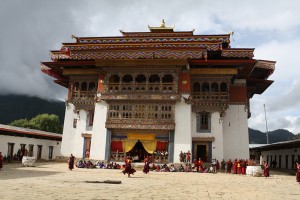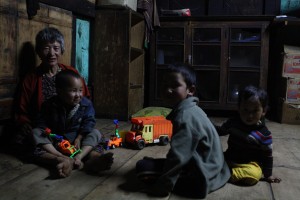Phobjikha
 From Thimphu, my next destination was Phobjikha valley. It was a 5 hour long drive till then. We crossed the Dochu La pass (3100m), where 109 chortens were recently built to commemorate an internal conflict. We then continued driving till Phobjikha valley. The drive was really stunning by itself. All of Bhutan resembles one gigantic nature park. Bhutan has a population of only 800,000. So most of the country appears totally empty. The landscape itself looks a lot like Switzerland, but unlike Switzerland where you have villages on top of the mountains, Bhutan’s mountains have only vegetation, prayer flags, cows and perhaps a few chortens. Every now and then, there would be a village of 4-5 houses, but that is it.
From Thimphu, my next destination was Phobjikha valley. It was a 5 hour long drive till then. We crossed the Dochu La pass (3100m), where 109 chortens were recently built to commemorate an internal conflict. We then continued driving till Phobjikha valley. The drive was really stunning by itself. All of Bhutan resembles one gigantic nature park. Bhutan has a population of only 800,000. So most of the country appears totally empty. The landscape itself looks a lot like Switzerland, but unlike Switzerland where you have villages on top of the mountains, Bhutan’s mountains have only vegetation, prayer flags, cows and perhaps a few chortens. Every now and then, there would be a village of 4-5 houses, but that is it.

Phobjikha valley is a lush green valley of farms, where people plant potatoes, turnips and mustard seeds. They have only started to have electricity a year ago. The migratory black-necked cranes come to Phobjikha valley at the end of every October. Since these birds are endangered and like dark places, the king felt that this area should not have electricity so as to not bother the birds. Only a year ago, he has finally given in. However, whenever it is the season for the birds to come to the valley, the villagers can only use electricity during certain hours.
 In Phobjikha valley, I visited the Gangtey Gompa which is a monastery built on top of a hill. I was lucky that the monks were also celebrating the tsechu festival at this monastery and so I got to see some of the dances in a more intimate and rudimentary setting. The festival felt more authentic and less like a show.
In Phobjikha valley, I visited the Gangtey Gompa which is a monastery built on top of a hill. I was lucky that the monks were also celebrating the tsechu festival at this monastery and so I got to see some of the dances in a more intimate and rudimentary setting. The festival felt more authentic and less like a show.
In Phobjikha, I was fortunate to spend the night in a farmhouse. My guide knew a family there and asked them if we could stay with them. Like in many Bhutanese homes, the family consisted of three generations living together in four rooms. The grandmother was only 37 years old, her daughter was 23 and the daughter herself had already three children.
Staying in this farmhouse felt more like time traveling rather than space traveling. Everything that we consumed that evening: the cheese, all of the vegetables, the meat, the alcohol, etc. came directly from the farm. For example, the daughter went out to milk the cow so that we had milk for our tea, and the grandmother used a wooden tool to beat the milk and turn it into butter for cooking. The family felt very honored to host us and prepared a feast for us. They cooked four different dishes that were all really delicious. My favorite one was the fresh cheese that they prepared with chili and garlic. In fact, everything that Bhutanese eat has lots of chili in it and when driving through a village, you always see lots of chili on the villagers’ roofs for drying. After dinner, they served us their home-made alcohol that tasted a lot like Japanese sake. However, they heat up the “sake” and mix it with lots of butter and egg yolk. The whole dinner took place on the floor around the wood oven, which also served as a heater for their home. The electricity went out multiple times, but the family was used to that and simply continued cooking in the dark.
 After dinner and drinks, we soon went to bed. The family gave us one of their rooms. We slept on the floor, but they gave each of us lots of blankets. I slept really well and only woke up in the morning from the noise of the cows and other farm animals. The family prepared our breakfast which was a mix of left-overs from the previous night, plus some Bhutanese pancakes. I also took a walk in the morning to explore the valley and see more of the farm life. It was fun to see many villagers dressed up on their way to the festival. In addition to the tsechu festival, there was also another festival that day to celebrate all of the machines in our life. As a result, many people decorated their tractors, cars and trucks with balloons. It was a real delight to see all of these decorated cars on our way to Bumthang.
After dinner and drinks, we soon went to bed. The family gave us one of their rooms. We slept on the floor, but they gave each of us lots of blankets. I slept really well and only woke up in the morning from the noise of the cows and other farm animals. The family prepared our breakfast which was a mix of left-overs from the previous night, plus some Bhutanese pancakes. I also took a walk in the morning to explore the valley and see more of the farm life. It was fun to see many villagers dressed up on their way to the festival. In addition to the tsechu festival, there was also another festival that day to celebrate all of the machines in our life. As a result, many people decorated their tractors, cars and trucks with balloons. It was a real delight to see all of these decorated cars on our way to Bumthang.
See more images here.
This entry was posted on Monday, September 23rd, 2013 at 3:25 pm and is filed under Travel Stories. You can follow any responses to this entry through the RSS 2.0 feed.


